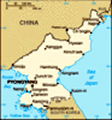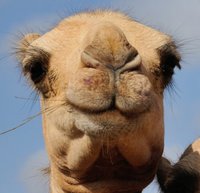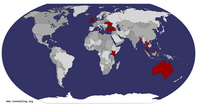COMING SOON HOUSE ADVERTISING ads_leader
Moments after arriving at Pyongyang train station, our hosts whisked us through a side exit and into a 25 seat van reserved only the two of us – there would be no fighting over who would get the window seat on this tour. We were introduced to our three North Korean hosts – our constant companions for the next 10 days. The Driver was a young person of about 30 years, with a wide face, darkened complexion, and a mop of black hair that swept across the head. Our Guide was in their early 50s, with a pleasant face that beamed when it did occasionally smile, but most times the expression matched the intensity of the words. The third person (also in their early 50s) was a stocky individual who was fluent in English, Korean, Chinese and Russian. We strongly suspect that this person was a party official who exerted a deal of influence over the other two.
We rushed through the darkened streets of Pyongyang to our hotel, and with an almost total absence of street-lighting, it was difficult to garner any impression of the city. At the hotel, we were given our final itinerary as well as strict
instructions on the photography restrictions we would be facing. Simply put – we were to photograph nothing unless we had the express permission of either the Guide or the Official. The Guide also gave us the option to indulge in that North Korean culinary specialty, dog meat. I expressed an interest in learning more, but fortunately (or unfortunately) nothing eventuated.
Upon retiring to my room, I turned on the television expecting to see revolutionary pronouncements, but no – I was greeted by images of BBC World! Of all the places I expected to watch the BBC, North Korea would have been last on my list. Thankfully I could watch all three government channels of North Korean TV. Their news reports featured a presenter with a forceful narrative informing the eager populace of the latest production targets and other important particulars of North Korean self-reliance. These were always accompanied by footage of orderly lines of workers applauding gently and dutifully waving flags and flowers at images of the Great Leader to celebrate another collective success. Sometimes, workers would give speeches, and the emotion of their achievement would move some of them to tears. The joys of state-run television.
Television

 My favourite Great Leader painting
My favourite Great Leader painting
A beautiful painting of the Great Leader with his son, Kim Jong Il (the Dear Leader) at the Pothoggang Hotel, Pyongyang, North Korea.drama was another staple of the programmers. These always showed ordinary Koreans successfully overcoming adversity – whether that be storms, fires or imperialist aggressors. They ended with the main protagonists tearfully celebrating their victory as grandiose music soared in the background. It was terribly melodramatic and reminiscent of a Bollywood movie – just minus the dancing and the saris.
The most appetising aspect of North Korean television was the cultural performances, which included the local orchestra or their western counterparts featuring Korean music or soloists. There was also the nightly revolutionary song performed by the rousing Korean People’s Army Merited Chorus – a massive choir of smartly uniformed men who singing was so impressive that I purchased two of their CDs. There were over twenty volumes of their music on sale, so they were also a popular choice amongst the locals.
A cloudy morning greeted our first full day in North Korea and we excitedly ate breakfast and joined our hosts to tour the capital of the most isolated country on earth. We drove through a strangely quiet Pyongyang; cars were sparse (though there were far more than I had previously presumed), but public transport was more frequent.
Pyongyang was largely destroyed during the Korean war, and the Soviet Union provided the town planning expertise that saw a city rebuilt with wide boulevards, rectangular grey and cream coloured buildings, and monuments aplenty – unique in Asia, but unsurprisingly similar to cities of the obsolete Soviet Bloc.
The first part of our tour focused on venerating the Great Leader, Kim Il Sung. He is credited as having liberated North Korean from imperialist aggression (both Japanese and American), developing its robust economy, and most importantly, he created that antithesis to globalisation, the
Juche philosophy, a North Korean ideal based on self-reliance. The word
Juche (pronounced jew-sher) is derived from two North Korean words that mean “master of body”. On a national scale, it is this philosophy that contributes much to North Korea’s isolation. Though he died over a decade ago, our hosts still referred to him as “Our Leader”, talking as if he was still alive. This was a correct assumption, for we were proudly informed that the Great Leader still lives in the hearts and minds of the Korean people.
The first important site we visited was the gargantuan bronze statue of the Great Leader at Mansu
Hill in Pyongyang, which we were required to honour with flowers. Backed by a huge mural of Mount Paektu (the symbolic birthplace of the Korean nation) we approached the statue and added our flowers to the already abundant collection of red, yellow and purple blossoms. We marched back a few steps and gave a deep bow before retiring to watch a constant stream of North Koreans perform the same ritual.
Examples of reverence for the Great Leader were everywhere. His pictures adorned the inside of every hotel and public building we entered, in addition to his ubiquitous visage appearing on billboards and statues across the land. Whenever you visited any site – whether that be a school, farm, education institution, historical site or a construction project – the local guide would tell us with a breathless awe how many times the Great Leader had toured the site, when was the occasion of the last visit, and the enlightened ideas he contributed to the success of the project. According to reports, people were so moved by the selflessness, generosity, love and revolutionary ideals of the Great Leader during these visits that their eyes were often “swimming with tears.” Any visit
would be marked by a display of photos and a map of his walking route through the building in question. As an added reminder of this auspicious occasion, plaques were placed at the rooms he had graced with his presence.
Though gazing wistfully at images of the Great Leader is respectful enough, the greatest homage is the pilgrimage to the Kumsusan Memorial Palace, his former residence where he permanently lies in state. It is a requirement that all men should wear a shirt, tie, trousers and dark shoes, but in keeping with my aim of being a “model tourist” I brought a whole suit, complete with fetching cufflinks – which impressed the Guide and Official to no end. This was important, for it was an easier time for all concerned if our hosts could trust us to respect their customs and ideals.
Upon arrival, we needed to remove all bulging objects from our pockets. There was some consternation about bringing my asthma medication (in case of overwhelming excitement) and it was only allowed to pass when the Guide agreed to carry it. After leaving my hat and camera in the cloak room, we needed to stand four abreast
before entering – which suited our small group (Guide, Official, Fi, and me) perfectly.
We were subjected to a full metal detector scan – men and women had separate queues, an appropriate decorum given has closely pressed and prodded I was by the male guard. After this intrusion, we boarded a series of travelators that conveyed us more than 200 metres down a massive corridor. We had to stand (and not walk) as it slowly carried us forward. On the opposite side of the hallway (only two metres away) and coming towards us, were clusters of tightly packed and well dressed North Koreans on travelators leaving the Mausoleum. All were sombre and downcast, and they silently stared at us as we silently stared at them. It was like two extremely long fish-tanks quietly passing each other – most bizarre.
Upon finally reaching the end of the hallway of travelators – and after washing and scrubbing our shoes on a conveniently placed floor facility, we turned right and boarded an escalator to enter the Mausoleum. This was a resplendent building smothered in marble, with the natural cream and grey patterns covering every centimetre of step, pillar, floor, wall and
ceiling. We again stood four abreast as we entered a capacious room, where at the far end, and in front of a wall illuminated by a red and white light, stood a gold statue of the Great Leader. Celestial music wafted around the airy interior and I audibly drew my breath at this sublime sight. We halted at a red line before the statue and bowed devotedly before exiting the room.
We were then given an audio guide for our walk through an area with images of grieving people. The small device pressed against my ear delivered a panegyric dripping with biblical prose. It revealed the “shattering bereavement” of the nation upon the Great Leader’s passing, and that this “Hall of Lamentation” shall forever mourn his demise. Totalitarian regimes sure do have a way with words. The conclusion pronounced that the Great Leader was a gift from the universe who will save all mankind through his
Juche philosophy. For any person who doubted that North Korea had deified the Kim Il Sung, this two minutes of flowery prose settled the issue as North Korea’s religion is an unyielding devotion to the Great Leader.
After returning our audio guides,

 Our room at the Yanggakdo Hotel - Pyongyang, North Korea
Our room at the Yanggakdo Hotel - Pyongyang, North Korea
This was the most luxurious hotel we stayed whilst in the country.we crouched slightly to pass through a purification chamber whose blasting air tussled our clothing and grooming. As everyone readjusted their hair, I felt a tingling sensation as we entered the final room, a towering columned enclosure bathed in a vermillion light. We stood four abreast as we approached the preserved Great Leader laying serenely within a glass case. Our small group approached the case, and in a meditative silence, we bowed at the feet of the Heavenly Leader. We moved clockwise to bow at his left side, and at this close angle, I could see he looked weighty, as one would expect from a person who had lain motionless for many years, and was attired in an immaculate dark suit. We proceeded around the head of the Great Leader (but did not bow) and gave our final bow to his right side. I watched the North Koreans in the room – the men looked positively distraught as they paid homage, and the women, all adorned in their finest traditional Korean clothes – held handkerchiefs to their faces to wipe away their tears. The only discernable sounds were of footsteps and the sniffling of mourners.
After leaving this room,

 Newsreader on North Korean TV.
Newsreader on North Korean TV.
She bowed at the commencement of every news bulletin.we were shown a display on the Great Leader’s extensive travels, including the train carriages donated by the Soviet Union and China that transported him around the country. After another travelator-related staring contest with more North Koreans when leaving the Mausoleum, the homage was concluded.
A visit to the Kumsusan Memorial Palace is one of the great pilgrimages of the world. I have visited many religious sites and this is one of the most powerful; it was easy to be swept along by the grief and devotion that permeates this place. To fully understand the emotions that are nurtured deep within the hearts and minds of the North Korean people, one must understand the enduring love they have for their Great Leader.
COMING SOON HOUSE ADVERTISING ads_leader_blog_bottom
Tot: 0.084s; Tpl: 0.017s; cc: 19; qc: 33; dbt: 0.0366s; 1; m:domysql w:travelblog (10.17.0.13); sld: 1;
; mem: 1.2mb































Sepulchre
Sepulchre
read with eagerness
Fascinating...do you think this place could become a tourist destination in itself - along the lines of Moscow, Hanoi, Beijing for weirdness?